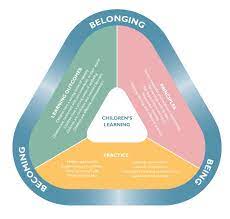Here are the sub-outcomes, evidence of when children can achieve them, and how educators can help children achieve EYLF Learning outcome 1: Children have a strong sense of identity.
Children grow more confident to explore and study when they feel secure, safe, and supported. Early childhood settings help children develop a sense of belonging by making them feel accepted and secure. They also establish attachments with those who care for them. Children explore their identity (physical, social and emotional, spiritual, and cognitive) through play.
Learning Outcome #1: Children have a strong sense of identity
1.1 Children are supported and feel secure.
It is obvious when children:
- Build secure attachments to one familiar educator and then to others.
- Use routines that will help you to make the transitions smooth.
- Feelings of belonging are essential to recognize and react to.
- Communicate their comfort and assistance needs.
- Maintain respectful and trusting relationships with children and educators.
- Openly expresses their thoughts and feelings in their interactions with other people.
- Respond to the ideas and suggestions of others.
- Engage in conversations and interactions with educators you trust.
- Play and relationships can help you explore the social and physical environment and interact with it confidently.
- Join in and initiate the play.
- Explore aspects of identity by role-playing.
Teachers can promote this learning through:
- Recognize and respond to the children’s signals and cues.
- Respond to the children’s attempts at initiating conversations and interactions.
- Support children’s attachment by providing consistent, warm, and nurturing relationships.
- Support children during the transition and help them bridge the gap between familiarity and unfamiliarity.
- Build on culturally-valued child-rearing and learning approaches.
- Children’s feelings and thoughts are encouraged when parents and teachers are available.
- It may take time for you to overcome feelings of fear, distress, or discomfort.
- Recognize each child’s individuality in positive ways.
- Spend time talking and interacting with each child.
1.2 Children learn to develop their sense of autonomy, interdependence, resilience, and agency.
It is obvious when children:
- Show an increased awareness of other people’s needs and rights.
- Be open to new experiences and challenges.
- Co-operate more and work with others.
- Take a calculated risk when making decisions and be prepared to deal with the unexpected.
- Recognize their achievements as well as those of others.
- Self-regulation is a sign of increasing self-regulation.
- Confidence is vital when tackling new situations.
- Start negotiating and sharing behaviors.
- When faced with a challenge, persist and try again.
Teachers can promote this learning through:
- Children need to be able to make decisions based on their knowledge.
- Promote children’s senses of belonging, connection, and well-being.
- Maintain high expectations for each child.
- Mediate or assist children in negotiating their rights concerning others’ rights.
- Give children the opportunity to play and work independently.
- Show your delight and excitement at the children’s efforts.
- Support children’s efforts by assisting them and encouraging them as necessary.
- Encourage and motivate children to overcome challenges.
- Give children the time and space to pursue their individual and collaborative interests.
- Build on the culturally valuable learning of each child’s community.
- Encourage children to make decisions and choices.
1.3 Children learn to be confident and knowledgeable about themselves.
It is obvious when children:
- Feel respected and acknowledged for who they indeed are.
- Explore different identities and perspectives in dramatic play.
- Share aspects of your culture with other children and educators.
- Use their native language to create meaning.
- Develop strong foundations in the culture and language(s) of their family and the larger community without compromising cultural identity.
- Engaging with community elders and members will help them to develop their cultural and social heritage.
- Reach out and communicate for comfort, assistance, and companionship.
- Celebrate and share your contributions and achievements.
Teachers can promote this learning through:
- Promote in all children an understanding of their identity and connection to others. This is a shared Australian identity.
- Ensure that all children feel proud and confident of their achievements.
- Share your child’s success with the family.
- Show respect for diversity by acknowledging that children, families, and communities have different approaches.
- Children construct meaning in a variety of ways.
- Plan for the children’s education with a thorough understanding of their child, family, and community contexts.
- Show children examples of how culture and identity are expressed.
- Build on culturally valuable approaches to learning.
- Build on the knowledge, language, and understanding of children.
- Talk to your children about the similarities and differences between people respectfully.
- Provide rich and diverse materials that reflect the social worlds of children.
- Listen to children and their understanding of themselves.
- Support the preservation of your native language and culture.
- Develop children’s authentic understanding of themselves.
1.4 Children are taught to treat others with empathy, care, and respect.
It is obvious when children:
- Show interest in the other children.
- Shared play is a great way to get together with others and have fun.
- Express a variety of emotions, ideas, and viewpoints constructively.
- Empathize and express concern with others.
- Show respect and awareness for other perspectives.
- Reflect on your actions and the consequences they may have for others.
Teachers can promote this learning through:
- During daily routines, engage in one-to-one interaction with children, especially babies and toddlers.
- Organise learning environments to encourage small-group interaction and play.
- Model care, empathy, and respect for staff, children, and families.
- Model explicit communication strategies that encourage children to engage in social interactions, play, and other activities in a way that fosters productive relationships.
- Recognize the complexity of children’s relationships and intervene sensitively in a way that encourages alternative perspectives and social inclusion.



